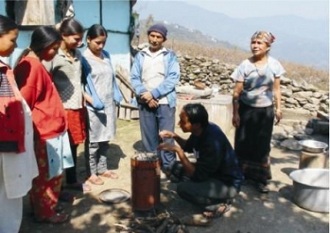From Kirk Smith’s website:
Effect of reducing indoor air pollution on women’s respiratory symptoms and lung function. RESPIRE Guatemala randomized trial.IN: Am J Epidemiology, 170(2): 211-220, 2009. (pdf, full-text)
Tone Smith-Sivertsen, Esperanza Dı´az, Dan Pope, Rolv T. Lie, Anaite Dı´az, John McCracken, Per Bakke, Byron Arana, Kirk R. Smith, and Nigel Bruce
Exposure to household wood smoke from cooking is a risk factor for chronic obstructive lung disease among women in developing countries. The Randomized Exposure Study of Pollution Indoors and Respiratory Effects (RESPIRE) is a randomized intervention trial evaluating the respiratory health effects of reducing indoor air pollution from open cooking fires. A total of 504 rural Mayan women in highland Guatemala aged 15–50 years, all using traditional indoor open fires, were randomized to either receive a chimney woodstove (plancha) or continue using the open fire. Assessments of chronic respiratory symptoms and lung function and individual measurements of carbon monoxide exposure were performed at baseline and every 6 months up to 18 months. Use of a plancha significantly reduced carbon monoxide exposure by 61.6%. For all respiratory symptoms, reductions in risk were observed in the plancha group during follow-up; the reduction was statistically significant for wheeze (relative risk ¼ 0.42, 95% confidence interval: 0.25, 0.70). The number of respiratory symptoms reported by the women at each follow-up point was also significantly reduced by the plancha (odds ratio ¼ 0.7, 95% confidence interval: 0.50, 0.97). However, no significant effects on lung function were found after 12–18 months. Reducing indoor air pollution from household biomass burning may relieve symptoms consistent with chronic respiratory tract irritation.



